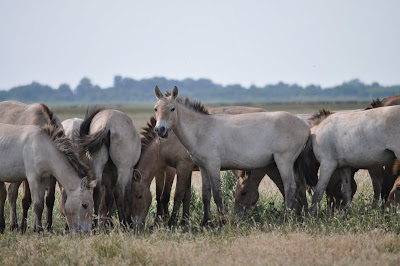One of the unexpected highlights of the trip to Hortobagy was a chance to view wild horses in a semi-natural setting. During my four day visit to the park, I spent five hours with park ranger and guide, Tamás Zalai. One of the many normally restricted places he took me was the wild horse reserve in the Pentezug puszta section of the park.
The Pentezug area is a 4000 hectare (aprox. 1000 acres) grassland that is surrounded by an electric fence to prevent the wild horses and a close relative of the now extinct aurochs, the Heck cattle (Bos primigenius), from wandering off into areas were their survival would be threatened. The fence is designed to allow native species of wildlife to move back and forth while preventing the movement of the larger introduced grazers.
The wild horses living in the reserve are Przewalski's (Equus ferus przewalskii). The 200 horses in the park are all descended from an original group of 17 horses donated from several zoos across Europe. The majority came from the Cologne Zoo in Germany. The biologists working with the horses are part of a team that has reintroduced Prezwalski's to their native habitat in the steppes of central Asia. The work they do with the horses in the Hortobagy's reserve provides important information regarding the ecology, behavior, and disease biology of transplanted horses, that will facilitate the reintroductions they are doing in Asia.
Like the few remaining non-reintroduced herds of Przewalski's, the horses in the Hortobagy have the same social system. Individuals are clustered into bands consisting of a band stallion, several breeding females, and their young. Once males are three years old they leave the band and congregate in herds with other bachelor males. With any luck, after several years of living as bachelors they will establish their own band and defend the females from other established band stallions and bachelor males trying to establish their own families.
In addition to facilitating work on wild introductions, the park managers' other goal for the management of the Przewalski's is to help establish and maintain the ecological conditions present in the park when wild and domesticated grazers were common on the Hungarian steppe. The Hortobagy used to have a different species of wild horse, the Tarpan (Equus ferus ferus), that was part of the grazing system that maintained the open landscape. I will write more about the importance of grazers in the Hungarian steppe's ecology in a subsequent post.





No comments:
Post a Comment